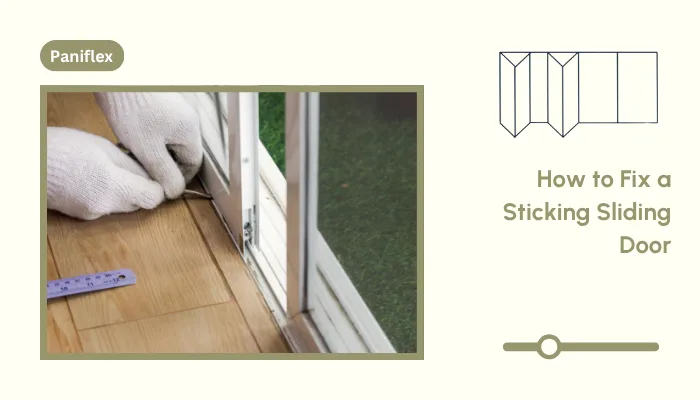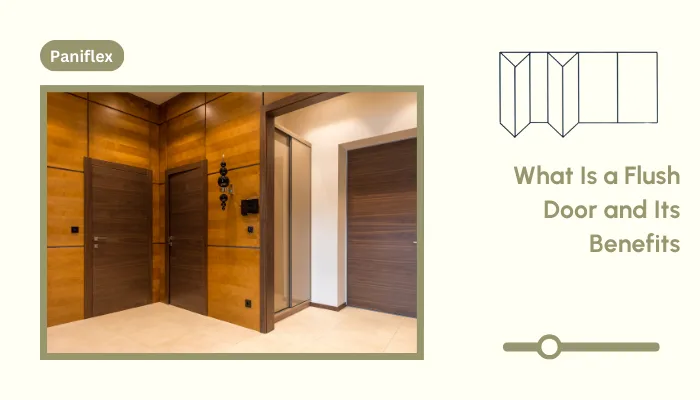Sliding doors are designed to offer smooth, space-saving operation, but over time, even well-installed systems can start to stick, drag, or resist movement. This issue is more than just inconvenient because wear, misalignment, or debris buildup increases friction and disrupts the door’s smooth movement, potentially leading to hardware damage or structural stress if not fixed promptly.
We understand how frustrating it can be when a door that once glided effortlessly begins to feel off-track or unstable. Whether the problem is minor or points to a larger underlying issue, a systematic approach makes it easier to diagnose and resolve the issue with the sliding door. This guide outlines the most common causes of sticking sliding doors and walks through practical steps to restore proper function.
Ready to experience the benefits of custom closet doors? Explore our range of Paniflex products now.
TL;DR
- Identify the Problem: Check for debris, warped tracks, or worn rollers since these are the usual suspects.
- Clean and Lubricate: A careful cleaning using appropriate tools and applying a silicone-based lubricant designed for sliding doors can often restore smooth sliding.
- Adjust or Replace Hardware: Tighten loose screws, realign tracks, or swap out old rollers for a smoother glide.
- Prevent Future Issues: Regular maintenance and using proper tools can save you from repeat repairs.
What Causes a Sliding Door to Stick?
A sticking sliding door is typically the result of multiple small issues that accumulate over time. While the symptoms may appear similar, such as jerky movement, resistance, or drag, the underlying cause of the problem can vary.
Identifying the right cause ensures the fix is effective and long-lasting. These are a few common causes of sticking sliding doors:
1. Track Obstruction
Dust, debris, or construction residue often accumulates at the bottom of the guide or track. Even a thin layer of buildup can interfere with the rollers, creating friction. This is especially common in high-traffic areas or unfinished spaces.
2. Worn or Misaligned Rollers
Over time, rollers may become flat, stop spinning, or move out of their proper place. This can cause the door panel to tilt or rub against the frame, making it difficult to open or close. Improper alignment also affects how the door’s weight is spread along the track.
3. Track Deformation
If the top or bottom track becomes bowed, dented, or misaligned, it will cause the panel to deviate from its proper path. Long-span installations or wall movement can introduce these issues. Even minor deviations can cause noticeable resistance.
4. Loose Hardware
Loose screws, brackets, or hangers can cause the door to sag slightly, allowing the bottom edge to drag across the floor or guide. Uneven weight distribution also places strain on the rollers. These small shifts often go unnoticed until friction builds up.
5. Structural Movement
Changes in the surrounding structure, such as floor settling, seasonal shifts, or frame distortion, can alter the door frame’s geometry and track alignment, causing the door to stick or bind during operation. This type of movement alters the geometry of the opening, putting stress on the door system. It is more common in older buildings or installations over flexible substrates.
Recognizing which of these conditions is present is the first step toward a lasting repair. The correct diagnosis prevents wasted effort and ensures smoother, more durable results. Before making any adjustments, it is vital to gather the right tools. The following section outlines the necessary tools needed to get started.
Tools and Materials Needed to Fix a Sliding Door
Most sticking issues can be resolved with standard tools and minimal replacement parts. Having these tools ready makes it easier to move through the diagnostic and repair steps without interruption. In many cases, a door that sticks can be resolved in under an hour with the right approach.
You would need the following:
- Cleaning Supplies: A soft brush or vacuum is essential for clearing out dirt, dust, and debris from the bottom guide and top track. A mild, non-abrasive cleaner and a lint-free cloth work together to help remove grime without scratching glass or metal surfaces.
- Basic Hand Tools: A flathead and Phillips screwdriver will be needed to remove access covers, adjust hardware, or tighten loose components. A hex key or Allen wrench may be required for changing the roller height, depending on the system.
- Lubricant: Use a silicone-based lubricant that is safe for use on metal and plastic components. Avoid using oil-based products, as they attract dust and debris and can exacerbate the problem over time.
- Level: A 24-inch or longer level helps check track alignment and ensure the panel hangs evenly. Proper leveling is key to identifying sag or misalignment that causes drag.
- Replacement Hardware (If Needed): If rollers, screws, or guides are worn or damaged, it is best to have compatible replacements ready. Always match replacement parts to the specific door system to maintain smooth operation and proper fit.
Once the right tools and materials are in place, the next step is a methodical inspection and correction process. Most sliding door issues can be resolved efficiently when each component is evaluated in sequence. The following section will help you isolate the problem and restore smooth operation with minimal disruption.
Suggested Watch: Watch this video to learn how to fix a stubborn, sticky sliding glass door by replacing the roller assemblies at the bottom of the door.
How to Fix a Sticking Sliding Door: Step-by-Step
In most cases, you can repair a sliding door without needing to remove the panel or replace the entire system. Restoring a sticking sliding door involves identifying the source of friction and making precision adjustments.
Each of the following steps addresses a specific cause of drag, ensuring efficient, long-lasting results.
1. Clear the Track and Guide
Begin by clearing the bottom guide and top track of all visible debris, dust, or adhesive residue. Use a vacuum with a crevice attachment to remove fine particles, then follow up with a nylon brush or compressed air to clean any buildup in corners. Once dry, wipe down both tracks with a cloth dampened with mild detergent or isopropyl alcohol, avoiding any residue.
Pro Tip: If the track is made of aluminum and visible, look for any signs of rust or small holes. You can gently polish rough areas with very fine steel wool to smooth the surface without damaging it.
2. Inspect the Rollers
Remove the access cap or lift the panel slightly to inspect the rollers without detaching the entire door. Check for signs of flat spots, seized bearings, or separation of the roller housing. Spin each roller by hand. If it resists or wobbles, it may be the root cause of sticking. Apply a dry silicone-based lubricant if the rollers are intact.
Pro Tip: If rollers are riveted in place, identify the OEM hardware or compatible retrofit kits before removal. Avoid mixing roller diameters or bracket types, which can affect clearance and door pitch.
3. Check Track Alignment
Use a spirit level to assess the alignment of both top and bottom tracks. Look for high or low points across the span, especially where tracks meet framing joints or anchors. Gaps between the level and track may indicate deformation or improper installation. If minor correction is needed, loosen mounting screws and use shims behind the track to re-establish alignment.
Pro Tip: For multi-panel systems, always measure alignment across all track segments, not just the central portion. Even a 3mm rise or dip over a long span can disrupt roller pathing and stress panel joints.
4. Adjust Roller Height
Access the roller adjustment screws, typically located at the base edge of the panel, using the appropriate screwdriver or hex key. Turn the panel clockwise to raise it, and counterclockwise to lower it. Make minor, even adjustments on both sides, checking the panel’s verticality and reveal clearance with each turn. The door should sit flush in the frame and glide freely.
Pro Tip: Measure the panel-to-floor clearance on both ends before and after adjustment. If one side shows more than 1/8″ variation, rollers may be seated unevenly, or roller brackets may be deformed.
5. Tighten Loose Hardware
Inspect all accessible fasteners, especially those securing the track, bottom guide, head rail, and carrier brackets. Vibration and repeated use can loosen these components over time. Use a hand screwdriver to retighten (rather than a power driver), especially in drywall or MDF, to prevent over-torquing. Confirm that stops, bumpers, and brackets are secure and not impeding movement.
Pro Tip: Apply a special adhesive called thread-locking compound to important screws and bolts if the door is used often or in places with a lot of vibration. This helps keep them from loosening..
6. Test and Repeat if Needed
Slide the door open and closed several times across its full range of motion. Feel for consistent resistance, gaps, or scraping sounds. Observe the bottom edge for lift or drag points and inspect the top track for contact marks. If performance is still uneven, revisit earlier steps, focusing on alignment and roller function.
Pro Tip: Place a sheet of paper under the bottom edge as you slide the door. If the paper snags or tears, the panel is still dipping or misaligned. This is a quick way to identify contact points without relying solely on visual inspection.
For installations where structural conditions or improper hardware contribute to recurring drag, escalation to advanced adjustment or component replacement may be necessary. In the next section, we will outline issues that require more in-depth solutions beyond standard fixes.
Suggested Read: How to Install Bifold Door Snugger: A Basic Guide
When to Stop Adjusting and Start Replacing?
Not every sticking door can be fixed with a screwdriver and lubricant. Sometimes, the issue lies deeper in the structure, the hardware system, or the door panel itself. Pushing ahead with basic fixes in these cases only delays a proper solution and can exacerbate the problem.
Below are clear signs that the repair may require more than a field adjustment.
1. Severe Frame Warping
If the frame or surrounding structure has visibly shifted due to floor settlement, header sag, or wall movement, adjustments to rollers and track will only offer temporary relief. Signs of this include diagonal panel gaps, uneven reveal lines, or doors that will not stay in position despite repeated leveling.
2. Cracked or Deformed Track
Aluminum or steel tracks that have bowed, dented, or split under pressure may no longer guide rollers effectively. Once track geometry is compromised, panels often derail or bind unpredictably. Track replacement is the only viable solution in these cases.
3. Roller Bracket Failure
If the roller bracket is cracked, bent, or separating from the panel, the door will no longer move smoothly, even with new rollers. In systems where brackets are embedded in the frame, improper removal can damage the door structure itself.
4. Glass Panel Concerns
Doors that use frameless or large-format glass panels require extra caution when handling. If the glass is under stress due to improper installation, binding can lead to stress cracks. Any adjustment near damaged glass should be avoided until the panel has been assessed or replaced.
5. Recurring Issues After Adjustment
If sticking problems return shortly after adjustment, despite proper cleaning and alignment, there may be deeper mechanical or structural inconsistencies. This could indicate an incompatibility between hardware components or issues with system installation.
In such situations, continuing to force adjustments on a compromised system risks damage to surrounding finishes, alignment tolerances, or safety features. Escalating the repair at the right time helps protect both the door system and the project outcome.
There are also several common mistakes you need to avoid while fixing a sliding door. These are explained in detail in the next section.
Suggested Read: How to Fix a Large Gap Under the Door?
Common Mistakes to Avoid While Fixing Sticking Sliding Doors
Even routine adjustments can go wrong if key details are missed or shortcuts are taken. Some fixes may seem harmless but can lead to long-term alignment issues, roller damage, or compromised performance.
Avoiding these common mistakes ensures a clean, lasting repair and preserves the integrity of the sliding door system.
- Over-lubricating the Track: Excess lubricant, especially grease-based products, attracts dirt and accelerates buildup. This creates more drag over time. Always use silicone-based lubricants sparingly and only where needed.
- Forcing Misaligned Panels: Sliding a door that is visibly off-track or scraping against the frame can damage rollers, guides, or even the glass panel. Realign or adjust before testing movement.
- Ignoring Structural Factors: Focusing only on the door itself without checking the surrounding floor or frame alignment can result in repeated sticking. Always check the level and geometry of the opening.
- Mixing Incompatible Hardware: Replacing rollers or guides with parts that do not match the original system can create new alignment problems. Always verify sizing, weight rating, and mounting style.
- Skipping Fastener Checks: Loose brackets or track anchors may not be visible at first, but can cause sag or instability. Always inspect and tighten all fasteners during the repair process.
Once the repair is complete, the job does not have to end there. A few well-timed maintenance tips can help your clients keep the door operating smoothly long after installation, while also reinforcing the quality of your work and encouraging long-term trust.
From the Community: Read this thread for handy tips from people dealing with badly sticking glass sliding doors.
Preventive Maintenance Tips to Share with Clients
A clean, well-adjusted sliding door reflects the quality of the installation, but long-term performance depends on how the system is maintained after handover. Offering a few simple care tips to clients can extend the life of the door and reduce callbacks. It also helps build trust and goodwill, reinforcing your role as a detail-oriented professional.
- Keep the Tracks Clear: Advise clients to vacuum or brush the bottom guide and top track every few weeks to maintain clear tracks. Debris buildup is the most common cause of friction. A quick pass with a soft brush or handheld vacuum makes a noticeable difference.
- Right Cleaning Products: Glass panels should be cleaned with non-ammonia-based solutions and a soft cloth. Harsh chemicals or abrasives can damage finishes and scratch frames. Remind clients to avoid spraying cleaner directly into the tracks.
- Reapply Lubricant Periodically: Suggest applying a silicone-based lubricant to rollers or guides every six months, or more often in high-use areas. A light coat is enough; excess product attracts dust and reduces effectiveness.
- Avoid Forceful Handling: Instruct clients not to slam panels shut or push against misaligned doors. Even a minor impact over time can loosen hardware or affect roller performance.
- Quick Check Once a Year: Encourage clients to visually inspect hardware and movement annually. If the door starts sticking again, it is easier to correct early than to wait for a complete realignment.
A small investment in client education often leads to referrals, fewer complaints, and a stronger professional reputation.
Even with proper repairs and regular maintenance, some doors are more prone to issues simply because they were not built for the space. When long-term reliability is the goal, starting with the right system makes all the difference. The following section explains why custom-made sliding doors consistently outperform standard options.
Why Do Custom-Made Doors Perform Better?
Pre-fabricated sliding doors often need on-site adjustments, workarounds, or hardware upgrades to function reliably. In contrast, custom-made doors are built to specification, ensuring precise alignment, a better fit, and a longer service life. When panels, tracks, and hardware are matched precisely to the opening, the system resists wear and operational issues more effectively.
Here is why custom sliding doors outperform standard options in the long run:
- Tailored Dimensions: When panels fit precisely, there is no drag, no binding, and less wear on rollers and guides.
- Better Weight Distribution: Custom systems are designed to handle the precise weight of each panel, taking into account the thickness of the materials used and the width of the door opening. This carefully designed mechanism reduces sagging and ensures even, smooth door movement.
- Tighter Tolerances: Hardware alignment stays intact because components are designed to work together, not forced to adapt on-site.
- More Durable Materials: Custom systems often utilize higher-quality materials, superior finishes, and commercial-grade hardware that withstands frequent use longer.
Custom Door & Mirror specializes in manufacturing sliding door systems that are tailored down to the quarter-inch, eliminating the need for on-site modifications or compensations. Our doors are available in a wide range of materials, including mirror, laminated glass, wood, and composite panels, all supported by commercial-grade hardware engineered for long-term use.
Each system is pre-assembled, measured to exact opening sizes, and designed for fast, accurate installation. This precision reduces labor time, minimizes call-backs, and ensures clean integration with adjacent finishes, whether the door is installed in a high-end residence or a large multi-unit build.
Suggested Read: DIY Guide: Installing Sliding Closet Doors on Concrete
Ready to experience the benefits of custom closet doors? Explore our range of Paniflex products now.
Conclusion
Sliding doors are designed for smooth, space-saving operation, but over time, common issues such as sticking, dragging, or resistance can develop. With the right tools, a systematic approach, and attention to installation details, most problems can be diagnosed and resolved without significant disruption.
If you aim to reduce service time, avoid field issues, and deliver a sliding door that works perfectly the first time, Custom Door & Mirror offers the precision and flexibility required. Every system is made to order, featuring accurate panel sizing, high-quality hardware, and a range of design finishes that complement your architectural vision.
Explore our materials, specifications, and configuration options today. Contact our team to discuss your next project.
Frequently Asked Questions
How do I get my sliding door to slide more easily?
Start by cleaning the tracks and removing debris. Lubricate the rollers and guides with a silicone-based product. Check for alignment issues or worn rollers. Adjust roller height if needed to ensure smooth, level travel across the entire track.
What is the best lubricant for a sliding glass door?
Use a dry, silicone-based lubricant designed for door hardware. It reduces friction without attracting dust or debris. Avoid using grease or oil-based products, as they can create buildup and worsen performance over time. Apply sparingly to rollers, guides, and contact points.
How to fix a sliding door that sticks?
Begin with a thorough track cleaning. Inspect rollers for wear and lubricate or replace if needed. Adjust roller height and confirm track alignment using a level. Tighten any loose hardware and test for smooth movement. Escalate if issues persist.
Can I use WD-40 on a sliding door?
It is not recommended since WD-40 is a solvent, not a lubricant. It may temporarily displace grime, but it will leave behind a residue that attracts dust. Use a proper silicone-based lubricant instead for clean, lasting performance without buildup.






